Fitness. Kraft und Schönheit
Kunstverein Jesteburg
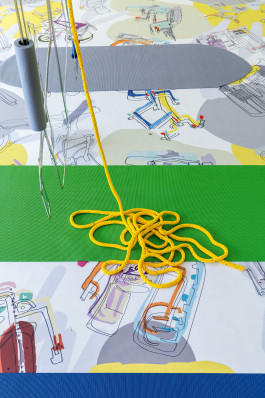
In her exhibition at the Kunstverein Jesteburg, Verena Issel focuses on the possibilities of ideological implementation in the context of practices of self-discovery and self-optimization. The exhibition is given a special local reference through the critical inclusion of questions of reception theory in the context of the neighboring Kunststätte Bossard. This is also reflected in the title of the exhibition—Kraft und Schönheit (Strength and Beauty), which quotes the title of a Lebensreform magazine of the same name (Kraft und Schönheit: Zeitschrift für vernünftige Leibeszucht [1901–1927], the monthly journal of the Verein für vernünftige Leibeszucht [Association for Responsible Physical Discipline]). Acceleration, growth, and the intensification of innovation are among the fundamental, structuring qualities of our contemporary Western society. As members of such a society, we are all subject to systemic imperatives that demand constant activity, flexibility, and self-optimization, as well as the constant accumulation of capital—be it economic, cultural, social, or physical. The so-called “elevator effect” attested to in the 1980s is increasingly absent in neoliberalism, giving way to multiple “slippery slopes” and everyday competition. In order to maintain the position we have achieved, we must now constantly improve, be even more innovative and creative, always remain flexible and agile. In response, terms like deceleration, resilience, and serenity are booming, along with yoga and mindfulness classes. The esoteric industry also owes its success to the situation described here. The concepts offered are often based on a longing for a different way of “being in the world.” But this also gives rise to various beliefs, such as: If you can adopt the right attitude, the world cannot harm you. Precisely because many of these practices promise a “better” life and are designed to help us become more resilient, they all too often conform to the imperatives of optimization and reproduce or manifest—only in a more mindful and pliable guise—the demands placed on the individual. From the past to the present, we can observe time and again how good intentions can also give rise to dangerous ideological potential—how esoteric life support and conspiracy theories, hippiesque and right-wing nationalist ideas can merge. In her exhibition, Verena Issel also traces these dynamics in the context of Johann Michael Bossard’s connection to the Lebensreform movement, his own ideological ideas, and especially with regard to the concepts of mediation theory currently prevalent in the neighboring Kunststätte. The Kunststätte Bossard has been in the news recently because a new museum building is being planned as part of a large federal grant. In the context of the debate about the co-financing from district funds, some voices have been raised criticizing the institution’s handling of Johann Michael Bossard’s National Socialist past. In particular, a swastika that Johann Michael Bossard had integrated into the floor mosaic directly at the entrance to the so-called “Edda Hall” in 1934 was widely discussed in the media. Although the symbol was clearly visible at the entrance to the room, it was only recently discovered by museum staff. In Germany, there are good reasons why it is forbidden to display a swastika in public without contextualizing it in terms of political education. Symbols like the swastika have to be explained, they have to be clarified, they have to be put into a context. However, when the swastika in the floor mosaic of the Edda Hall was brought to public attention, the Kunststätte Bossard decided to lay a carpet over the symbol. Once again, without leaving any written commentary accessible to everyone. Verena Issel’s exhibitions very often respond specifically to the exhibition venue, its surroundings, its perception, its architecture, or its history. For this reason, in the run-up to her exhibition at the KVJ, the artist also visited the Kunststätte, where she also booked a public tour in order to get a more detailed picture of the situation. Unfortunately, it quickly became clear that the Kunststätte Bossard is a classic example of how a backward-looking, obfuscating, whitewashing discourse that avoids confrontation with Nazi crimes has come to dominate the debate on National Socialism. This practice of dealing with the past is unfortunately far from new in Germany, as in other parts of the world, and is currently reflected in the debate on colonialism. In her exhibition Fitness. Kraft und Schönheit, Verena Issel makes clear reference to the mediation practice of the Kunststätte Bossard, which can be seen as exemplary for the way many people deal with the past, and translates her observations and critical, questioning thoughts into multifaceted art: An elaborate floor piece in contemporary garb creates a direct link to Bossard’s mosaic in the Edda Hall, while the video work produced especially for the exhibition—in which the costumes of the performers also refer specifically to the Kunststätte—can be read as a translation of how willing society is to sweep things under the rug or not question them closely as long as they appear to us at first glance to be pleasant, pleasing, and harmless in their decorative quality. In Verena Issel’s exhibition, the classic instruments of art mediation remain what they are, but in the context described here, they also become exhibits themselves. The reader compiled for the exhibition, which enables visitors to delve deeper into the public debate surrounding the Kunststätte Bossard, the museum-didactic publication Kraft und Schönheit, and the detailed text explaining the origin and use of the swastika retain their function as museum educational tools, but at the same time also become part of Verena Issel’s installation work: It is exhibited as it should actually be exhibited. Although the local relevance of the exhibition is more than clear, especially in Jesteburg, the theme of the exhibition is unfortunately a general and highly topical one: As a publicly funded institution, it is our duty to inform all visitors transparently and comprehensively, and as vigilant democratic citizens, we must help to ensure that history is critically scrutinized everywhere, especially in public spaces. ☐ Isa Hänsel
INGREDIENTS:
- Stair Master
- Stepper
- Spinning Bike
- Ideologischer Boden
- Kraft und Schönheit
- Grassroots movement
- Kraft und Schönheit, Zeitschr. für vernünft. Leibeszucht
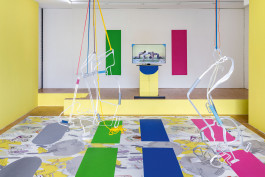
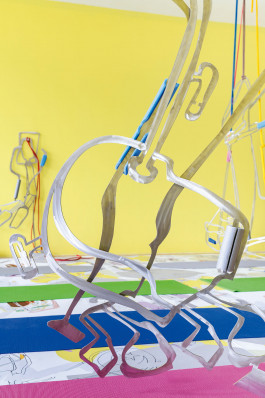
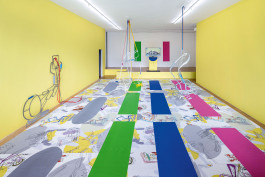
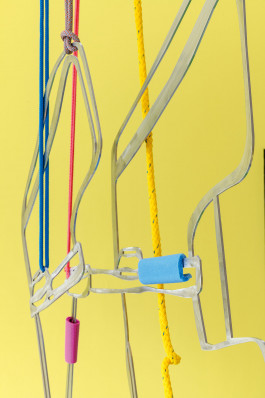

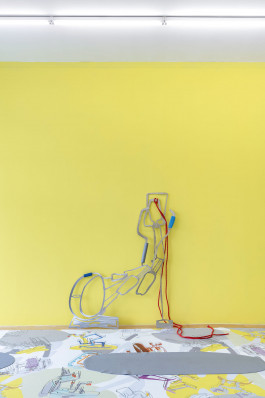
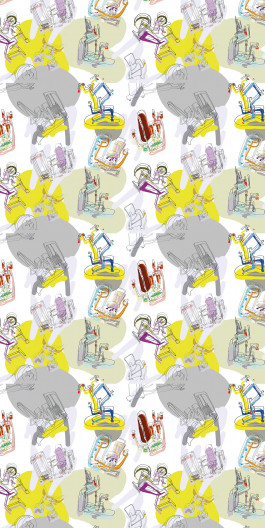
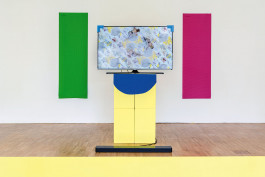
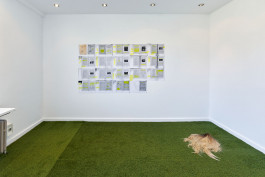
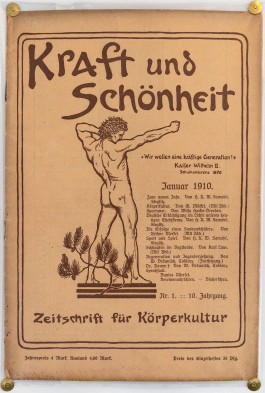
Stair Master (Hanging object on the left)
2021, ropes, stainless steel with ship ropes and foam, 186 × 150 cm,
Stepper (Object on the right)
2020, ropes, stainless steel with ship ropes and foam, 186 × 150 cm, Installation view Kunstverein Jesteburg
Fitness. Kraft und Schönheit (detail)
2020, various works, floor with drawings, yoga mats, video installation, dimensions variable, Installation view Kunstverein Jesteburg
Fitness. Kraft und Schönheit,
2020, various works, floor with drawings, yoga mats, video installation, dimensions variable, Installation view Kunstverein Jesteburg
Fitness. Kraft und Schönheit (detail),
2020, Installation view Kunstverein Jesteburg
Fitness. Kraft und Schönheit (detail)
2020, Installation view Kunstverein Jesteburg
Spinning Bike
2020, ropes, stainless steel with ship ropes and foam, 186 × 150 cm, Installation view Kunstverein Jesteburg
Fitness. Kraft und Schönheit (detail)
2020, drawings on the floor in reaction to the local Kunststätte Bossard, a museum in which a swastika is still found on the floor mosaic. At the time of this exhibition, the government funded museum merely covered the nazi symbol with a carpet, without any further comments, Installation view Kunstverein Jesteburg
Fitness. Kraft und Schönheit (detail)
2020, Video installation, Installation view Kunstverein Jesteburg
Grassroots movement,
2020, artificial turf, blonde wig, original editions of the proto-fascist life reform magazine “Kraft und Schönheit” from 1909/10 including reading copies and newspaper articles on the Bossard art site and information texts on political symbols
Kraft und Schönheit: Zeitschr. für vernünft. Leibeszucht
Hier präsentierte Ausgaben erschienen Dez. 1909/Januar 1910 [1. Ausgabe]1901/02; 2.1902/03; 3.1903 – 26.1927; damit Ersch. eingest. Berlin: Kraft und Schönheit, Installation view Kunstverein Jesteburg, 2020